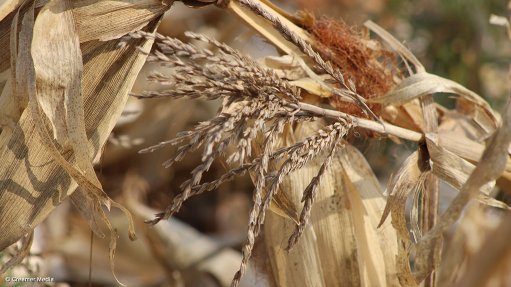
Photo by: Megan van Wyngaardt
Aimed at alleviating poverty and uplifting the rural communities of central Eastern Cape, 145 ha of the Eastern Cape Rural Development Agency’s (ECRDA) Ncora rural enterprise development (Red) hub were harvested for a second year, on Tuesday.
The ECRDA had planted 1 000 ha of maize in Ncora in the 2014/15 season on land owned by community members, who were organised around ten primary cooperatives. This formed part of the Development Bank of Southern Africa’s (DBSA’s) agroprocessing initiative.
Speaking to Engineering News Online, ECRDA agronomist Luvo Qongqo said that, through yield estimates carried out by Santam Agri, the R49.5-million 145 ha Ndenxe Sangeni cooperative would produce about 4.8 t of maize per hectare.
Some 696 t of maize was expected to be harvested this season.
The R49-million had been used to cover primary production; to buy eight tractors, two harvesters, implements and bakkies; and to build two 1 000 t grain silos, a milling shed, a trading shed and a mill.
The Ndenxe Sangeni cooperative spent about R7 400/ha to plant the maize, but would, at current maize prices averaging R2 600/t , make a profit. The maize was being sold to a nearby dairy, which also formed part of the Ncora Red hub.
“This cooperative has about 60 beneficiaries and, when the dairy has paid the committee, the [money] is distributed equally among the members,” Qongqo said.
Ncora/Qhumaci Producers Secondary Cooperative chairperson Phumzile Boyani said that, once the yield was determined after the harvest, the scheme would decide how much should go back to the landowners. He estimated that this was usually 5% to 10% of the yield, while the rest was sold to the market.
Revenues generated from the sale of the maize went back into planting for the new season, which Qongqo said would start in October.
The total area of the Ncora Red hub comprised 1 003 ha of land for the cultivation of white maize, holding ten primary cooperatives, or 706 beneficiaries.
Also forming part of this initiative was the Ncora irrigation scheme, with 3 000 ha under irrigation, while 2 000 ha remained dry land.
Qongqo said the development had not been without challenges, noting that late planting reduced the possible yield of the cooperative. He added that the ECRDA had to have weekly meetings with the communities to encourage farmer participation.
Further, Qongqo said that, as many rural families did not have food to survive, theft had become a problem. However, he pointed out that the cooperative had, from the previous year’s profits, fenced the 145 ha and appointed rangers to keep thieves and livestock away from the crops.